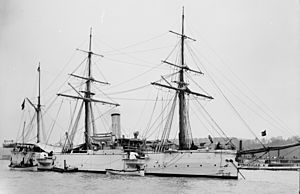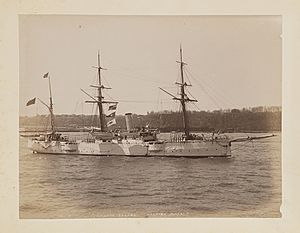Spanish cruiser Infanta Isabel facts for kids

Infanta Isabel in New York, May 1893
|
|
Quick facts for kids History |
|
|---|---|
| Name | Infanta Isabel |
| Namesake | Isabella, Princess of Asturias |
| Builder | Naval shipyard Cadiz |
| Laid down | 1883 |
| Launched | 24 June 1885 |
| Completed | 1887 |
| Fate | Stricken 1927 |
| General characteristics | |
| Class and type | Velasco-class unprotected cruiser |
| Displacement | 1,152 tons |
| Length | 210 ft 0 in (64.01 m) |
| Beam | 32 ft 0 in (9.75 m) |
| Draft | 13 ft 8 in (4.17 m) maximum |
| Installed power | 1,500 ihp (1,100 kW) |
| Propulsion | 1-shaft, horizontal compound, 4-cylinder boilers |
| Sail plan | Barque-rigged |
| Speed | 13 knots (24 km/h; 15 mph) |
| Complement |
|
| Armament |
|
| Notes | 200 to 220 tons of coal (normal) |
Infanta Isabel was a Velasco-class unprotected cruiser of the Spanish Navy.
Technical characteristics
Infanta Isabel was built at the naval shipyard at Cadiz. Her keel was laid in 1883 and the ship was launched on 24 June 1885. The vessel was completed in 1887. She had one rather tall funnel. Infanta Isabel had an iron hull and was rigged as a barque.
Visit to the United States
In May 1893 Infanta Eulalia visited the United States; she traveled first to Puerto Rico, then to Havana, Cuba, arriving in New York on 18 May on the Infanta Isabel, before making her way to Washington, D.C., where she was received by President Grover Cleveland at the White House. The Infanta Isabel stayed on in New York as a part of the Grand Naval Review there.
In early January 1903, Infanta Isabel was sent to Morocco, to protect Spanish citizens and interests during the unrest there.
Infanta Isabel was rebuilt in 1911, and by 1921 her armament had become one 66 mm (2.6 in) and ten 57 mm (2.2 in) guns and her complement had risen to 194. She was stricken in 1927, by far the longest-lived ship of her class.
See also
 In Spanish: Infanta Isabel (1883) para niños
In Spanish: Infanta Isabel (1883) para niños


